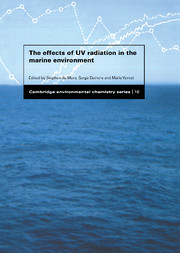Book contents
- Frontmatter
- Contents
- Contributors
- Preface
- 1 Enhanced UV radiation – a new problem for the marine environment
- 2 UV physics and optics
- 3 Spectral weighting functions for quantifying effects of UV radiation in marine ecosystems
- 4 Marine photochemistry and its impact on carbon cycling
- 5 Photochemical production of biological substrates
- 6 Mechanisms of UV damage to aquatic organisms
- 7 Strategies for the minimisation of UV-induced damage
- 8 UV radiation effects on heterotrophic bacterioplankton and viruses in marine ecosystems
- 9 Effects of UV radiation on the physiology and ecology of marine phytoplankton
- 10 Impact of solar UV radiation on zooplankton and fish
- 11 Implications of UV radiation for the food web structure and consequences on the carbon flow
- Index
5 - Photochemical production of biological substrates
Published online by Cambridge University Press: 20 August 2009
- Frontmatter
- Contents
- Contributors
- Preface
- 1 Enhanced UV radiation – a new problem for the marine environment
- 2 UV physics and optics
- 3 Spectral weighting functions for quantifying effects of UV radiation in marine ecosystems
- 4 Marine photochemistry and its impact on carbon cycling
- 5 Photochemical production of biological substrates
- 6 Mechanisms of UV damage to aquatic organisms
- 7 Strategies for the minimisation of UV-induced damage
- 8 UV radiation effects on heterotrophic bacterioplankton and viruses in marine ecosystems
- 9 Effects of UV radiation on the physiology and ecology of marine phytoplankton
- 10 Impact of solar UV radiation on zooplankton and fish
- 11 Implications of UV radiation for the food web structure and consequences on the carbon flow
- Index
Summary
Introduction
Solar radiation initiates a wide variety of photochemical transformations in natural waters, ranging from primary photolyses involving well-defined chromophores to complicated photoreactions involving ill-defined chromophores, such as humic substances.The broad spectrum of photochemical transformations that have been documented attest to the importance of photochemistry in aquatic biogeochemical cycles (Zafiriou, 1977; Zika, 1981; Larson & Berenbaum, 1988; Cooper et al., 1989; Hoigné et al., 1989; Blough & Zepp, 1990; Helz, Zepp & Crosby, 1994; Zepp, Callaghan & Erickson, 1995;Blough, 1997; Moran & Zepp, 1997). These transformations are driven largely by the absorption of light by dissolved organic matter (DOM), principally in the ultraviolet (UV) region of the solar spectrum (λ < 400 nm).
Currently, it is not possible to assess quantitatively the effects of various photochemical processes on plankton in marine and freshwater environments. A comprehensive understanding of the nature of photochemical–biological interactions in aquatic systems is lacking, at both the cellular and the ecosystems levels. There is evidence for short term deleterious effects of UV radiation including DNA damage (Karentz, Cleaver & Mitchell, 1991), inhibition of photosynthesis (Cullen, Neale & Lesser, 1992; Smith et al., 1992) and decreased nutrient uptake (Döhler et al., 1991). It is also clear that organisms have mechanisms to repair damage and screen incident UV radiation (Vincent & Roy, 1993; Karentz, 1994; and see Chapter 8). As may be expected, there is considerable interspecies sensitivity to short and long term exposure to UV radiation that may lead to changes in the community structure favouring UV-resilient species (Calkins & Thordardøttir, 1980; Worrest, Thomson & Van Dyke, 1981; Worrest, 1983). However, some of the changes that are observed are counter-intuitive and make sense only through examination of trophic level interactions.
- Type
- Chapter
- Information
- The Effects of UV Radiation in the Marine Environment , pp. 130 - 148Publisher: Cambridge University PressPrint publication year: 2000
- 11
- Cited by



